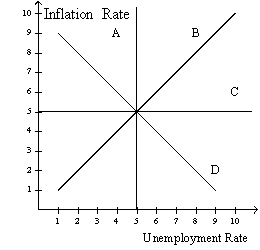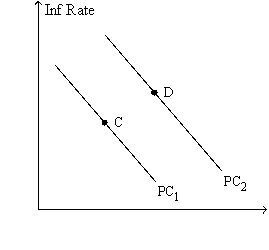A) vertical stems from the analysis of Samuelson and Solow.
B) vertical stems from the analysis of Friedman and Phelps.
C) vertical was disproved by the experiment that monetary and fiscal policymakers inadvertently created in the 1970s.
D) downward-sloping can be correct if unemployment responds very quickly to unexpected inflation.
F) A) and D)
Correct Answer

verified
Correct Answer
verified
Multiple Choice
Which of the following is upward-sloping?
A) both the long-run and the short-run Phillips curve
B) neither the long-run nor the short-run Phillips curve
C) the long-run Phillips curve, but not the short-run Phillips curve
D) the short-run Phillips curve, but not the long-run Phillips curve
F) A) and B)
Correct Answer

verified
Correct Answer
verified
Multiple Choice
How would a decrease in the natural rate of unemployment affect the long-run Phillips curve?
A) It would shift the long-run Phillips curve right.
B) It would shift the long-run Phillips curve left.
C) There would be an upward movement along a given long-run Phillips curve.
D) There would be a downward movement along a given long-run Philips curve.
F) B) and D)
Correct Answer

verified
Correct Answer
verified
Multiple Choice
In the late 1960s, Milton Friedman and Edmund Phelps argued that
A) the trade-off between inflation and unemployment did not apply in the long run This claim is consistent with monetary neutrality in the long run.
B) the trade-off between inflation and unemployment did not apply in the long run. This claim is inconsistent with monetary neutrality in the long run.
C) the trade-off between inflation and unemployment applied in both the short run and the long run. This claim is consistent with monetary neutrality in the long run.
D) the trade-off between inflation and unemployment applied in both the short run and the long run. This claim is inconsistent with monetary neutrality in the long run.
F) B) and C)
Correct Answer

verified
Correct Answer
verified
Multiple Choice
Figure 17-6
Use the two graphs in the diagram to answer the following questions.
 -Refer to Figure 17-6. Starting from C and 3, in the short run, an unexpected decrease in money supply growth moves the economy to
-Refer to Figure 17-6. Starting from C and 3, in the short run, an unexpected decrease in money supply growth moves the economy to
A) A and 1.
B) B and 2.
C) back to C and 3.
D) D and 4.
F) A) and C)
Correct Answer

verified
Correct Answer
verified
Multiple Choice
Figure 17-6
Use the two graphs in the diagram to answer the following questions.
 -Refer to Figure 17-6. The economy would move from C to B
-Refer to Figure 17-6. The economy would move from C to B
A) in the short run if money supply growth increased unexpectedly.
B) in the short run if money supply growth decreased unexpectedly.
C) in the long run if money supply growth increases.
D) in the long run if money supply growth decreases.
F) A) and D)
Correct Answer

verified
Correct Answer
verified
Multiple Choice
Figure 17-4
 -Refer to figure 17-4. In this order, which curve is a long-run Phillips curve and which is a short-run Phillips curve?
-Refer to figure 17-4. In this order, which curve is a long-run Phillips curve and which is a short-run Phillips curve?
A) A, B
B) A, D
C) C, B
D) None of the above is correct.
F) B) and D)
Correct Answer

verified
Correct Answer
verified
Multiple Choice
According to Friedman and Phelps, policymakers face a tradeoff between inflation and unemployment
A) only in the long run.
B) only in the short run.
C) in neither the long run nor short run.
D) in both the short run and long run.
F) All of the above
Correct Answer

verified
Correct Answer
verified
Multiple Choice
Suppose that the money supply increases. In the short run, this increases prices according to
A) both the short-run Phillips curve and the aggregate demand and aggregate supply model.
B) neither the short-run Phillips curve nor the aggregate demand and aggregate supply model.
C) the short-run Phillips curve, but not the aggregate demand and aggregate supply model.
D) the aggregate demand and aggregate supply model but not the short-run Phillips curve.
F) A) and C)
Correct Answer

verified
Correct Answer
verified
Multiple Choice
From 1993-2001 the U.S. economy experienced
A) relatively low inflation and unemployment rates.
B) relatively high inflation and unemployment rates.
C) relatively low inflation rates and relatively high unemployment rates.
D) relatively high inflation rates and relatively low unemployment rates.
F) A) and C)
Correct Answer

verified
Correct Answer
verified
Multiple Choice
In the long run, inflation
A) and unemployment are primarily determined by labor market factors.
B) and unemployment are primarily determined by the rate of money supply growth.
C) is primarily determined by the rate of money supply growth while unemployment is primarily determined by labor market factors.
D) is primarily determined by labor market factors while unemployment is primarily determined by the rate of money supply growth.
F) A) and B)
Correct Answer

verified
Correct Answer
verified
Multiple Choice
If the Federal Reserve increases the rate at which it increases the money supply, then unemployment is lower
A) in the long run and the short run.
B) in the long run but not the short run.
C) in the short run but not the long run.
D) in neither the short run nor the long run.
F) A) and B)
Correct Answer

verified
Correct Answer
verified
Multiple Choice
If inflation expectations rise, the short-run Phillips curve shifts
A) left. If inflation remains the same, unemployment falls.
B) left. If inflation remains the same, unemployment rises.
C) right. If inflation remains the same, unemployment falls.
D) right. If inflation remains the same, unemployment rises.
F) None of the above
Correct Answer

verified
Correct Answer
verified
Multiple Choice
The Volcker disinflation
A) had virtually no impact on output, just as the classical dichotomy suggested.
B) was associated with rising output, perhaps due to expansionary fiscal policy.
C) caused output to fall, but by less than the typical estimate of the sacrifice ratio suggested.
D) None of the above is correct.
F) C) and D)
Correct Answer

verified
Correct Answer
verified
Multiple Choice
Suppose the central bank pursues an unexpectedly tight monetary policy. In the short-run the effects of this are shown by
A) moving to the left along the short-run Phillips curve.
B) moving to the right along the short-run Phillips curve.
C) shifting the short-run Phillips curve to the right.
D) shifting the short-run Phillips curve to the left.
F) C) and D)
Correct Answer

verified
Correct Answer
verified
Multiple Choice
Figure 17-8. The left-hand graph shows a short-run aggregate-supply (SRAS) curve and two aggregate-demand (AD) curves. On the right-hand diagram, "Inf Rate" means "Inflation Rate."

 -Refer to Figure 17-8. The shift of the aggregate-supply curve from AS1 to AS2 could be a consequence of
-Refer to Figure 17-8. The shift of the aggregate-supply curve from AS1 to AS2 could be a consequence of
A) an increase in the money supply.
B) an adverse supply shock.
C) a decrease of output from Y1 to Y2.
D) a slow adjustment of people's expectation of the inflation rate.
F) B) and D)
Correct Answer

verified
Correct Answer
verified
True/False
An adverse supply shock shifts the short-run Phillips curve to the left.
B) False
Correct Answer

verified
Correct Answer
verified
Multiple Choice
Figure 17-2
Use the pair of diagrams below to answer the following questions.
 -Refer to Figure 17-2. If the economy starts at C and 1, then in the short run, a decrease in taxes moves the economy to
-Refer to Figure 17-2. If the economy starts at C and 1, then in the short run, a decrease in taxes moves the economy to
A) D and 2.
B) D and 3.
C) back to C and 1.
D) None of the above is correct.
F) A) and B)
Correct Answer

verified
Correct Answer
verified
Multiple Choice
Samuelson and Solow reasoned that when aggregate demand was low, unemployment was
A) high, so there was upward pressure on wages and prices.
B) high, so there was downward pressure on wages and prices.
C) low, so there was upward pressure on wages and prices.
D) low, so there was downward pressure on wages and prices.
F) A) and B)
Correct Answer

verified
Correct Answer
verified
Multiple Choice
Friedman and Phelps concluded that
A) in the long run the Phillips curve is downward sloping, which is consistent with classical theory.
B) in the long run the Philips curve is downward sloping, which is inconsistent with classical theory.
C) in the long run the Phillips curve is vertical, which is consistent with classical theory.
D) in the long run the Phillips curve is vertical, which is inconsistent with classical theory.
F) C) and D)
Correct Answer

verified
Correct Answer
verified
Showing 181 - 200 of 367
Related Exams